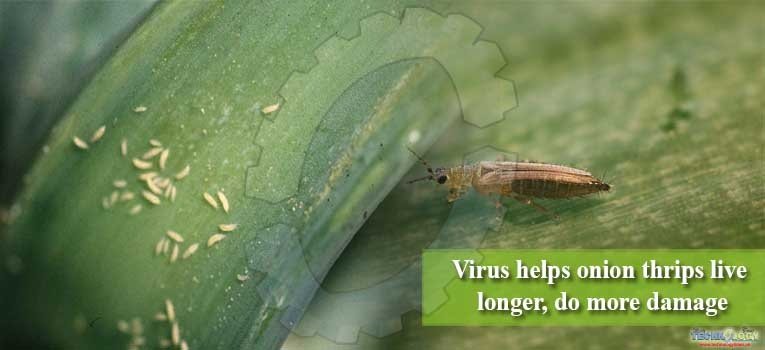Onion harvests are defenseless against an infection known as Iris yellow spot infection (IYSV), which they procure from creepy crawly bugs called onion (Thrips tabaci).
 IYSV causes corruption in onion plant tissues and prompts a great many dollars of yield misfortunes every year. Thrips can get the infection from tainted onion plants when they are hatchlings, and, when contaminated, the thrips can spread the infection to other onion plants for the duration of their lives.
IYSV causes corruption in onion plant tissues and prompts a great many dollars of yield misfortunes every year. Thrips can get the infection from tainted onion plants when they are hatchlings, and, when contaminated, the thrips can spread the infection to other onion plants for the duration of their lives.
Past research found that disease with plant infections in the class Tospovirus expanded life expectancy and fruitfulness in an alternate types of thrips called bloom thrips. As of late, scientists at Cornell University led an examination to test if IYSV influences life expectancy and fruitfulness in onion thrips.
The examination group thought about the life expectancy and fruitfulness of onion thrips that were contaminated with the infection with thrips that were not tainted. To do as such, they assembled onion plants from fields in which IYSV was available, kept up the plants in the lab, and presented thrips to the onion plants with the goal that they could get the infection and lay eggs.
They at that point permitted the subsequent eggs to create to pupation. They expelled pupae and set them on plates of cabbage leaf as a developing medium.
At the point when onion thrips rose up out of pupation, the specialists checked their survival and multiplication at regular intervals all through their life expectancy. All thrips in the analysis were female, and their eggs formed into larval thrips parthenogenically (without preparation).
One hundred and forty-nine thrips were utilized in the analysis. The examiners decided if singular thrips had turned out to be tainted with IYSV by testing for nearness of an IYSV nucleoprotein quality utilizing a system known as invert transcriptase polymerase chain response.
Past investigations did not decide if thrips were contaminated with tospoviruses; by deciding disease status, Leach and partners made more prominent measurable power than was accessible in past work.
Of the 149 thrips tried, 77 percent were contaminated with IYSV. The specialists found that thrips contaminated with IYSV lived 3.6 days (or 22 percent) longer all things considered than uninfected thrips. They found no huge distinction in fruitfulness, be that as it may, among contaminated and uninfected thrips.
Understanding the environment of disease is imperative to creating the executives plans for plant infections in the field, IYSV is a significant infection in onion generation, and seeing how onion thrips are affected by IYSV can enable us to more readily comprehend the more prominent the study of disease transmission of IYSV.
The expanded survivor ship is doubly noteworthy from a farming stance. Onion thrips feed by making a gap in onion forgets and sucking plant juices. This diminishes the capacity of the plant to photosynthesize, causes loss of water, and makes a passage point for plant illnesses which are all hindering to onion plants and can cause crop misfortunes.
By expanding the survivorship of onion thrips, onion thrips can accomplish more harm to onion plants. Likewise, onion thrips feed on various plants, and once in a while different harvest fields, thus, by expanding their life expectancy, they have a superior shot of contaminating more onion plants with IYSV, which is additionally unfavorable to the onion plants.
One captivating part of Leach’s discoveries is that lone 77 percent of the onion thrips that were offered access to contaminated onion plants wound up tainted. For what reason did a few thrips become tainted and some not become contaminated? Is it because of contrasts in physiology, nourishing conduct, or different elements?
Past examinations have demonstrated that IYSV will in general be unevenly disseminated all through the plant, so the nourishing area of thrips may fundamentally change the probability of that thrips gaining the infection It’s conceivable that we can have two thrips benefiting from a similar plant, and one may procure the infection and the other may not, as per where every encouraging during larval improvement.
Another fascinating inquiry that emerges from the examination: How does IYSV increment life span in onion thrips? Past writing has given some extraordinary theories to why IYSV may bestow expanded life span, incorporating changes in the thrips midgut work from the tospovirus contamination.
But the impact of tospoviruses on thrips will in general yield conflicting outcomes, and the impacts are probably going to contrast dependent on the particular species and populaces examined.
Past investigations have seen that tospoviruses can cause changes in factors, for example, nourishing conduct, advancement timing, and diet decisions in thrips.
In their paper, Leach and associates notice that, to advance our comprehension of how tospoviruses can cause such changes, near research is required on various detaches of IYSV and various populaces of thrips.
Different investigations have been distributed taking a gander at the impacts of tospoviruses on thrips, and we figure these examinations could fill in as a format for extra research with IYSV and onion thrips.
For instance, it is helpful to analyze if there is a distinction in sustaining conduct among contaminated and non-tainted onion thrips and how those progressions may affect the more prominent nature of onion thrips in onion.
The subject of tospoviruses and thrips is captivating in that the two species harm crops and the two species cooperate with one another such that expands the harm every specie can cause to crops.
Future research guarantees to add to our comprehension of these mind boggling infection creepy crawly crop communications and give continuous enhancements in the executives of both tospoviruses and their bug vectors.
Authors: Muhammad Nabeel Saleem, Dr. Shahid Majeed , Dr. Muhammad Arshad (Department of Entomology, University of Agriculture Faisalabad Pakistan)